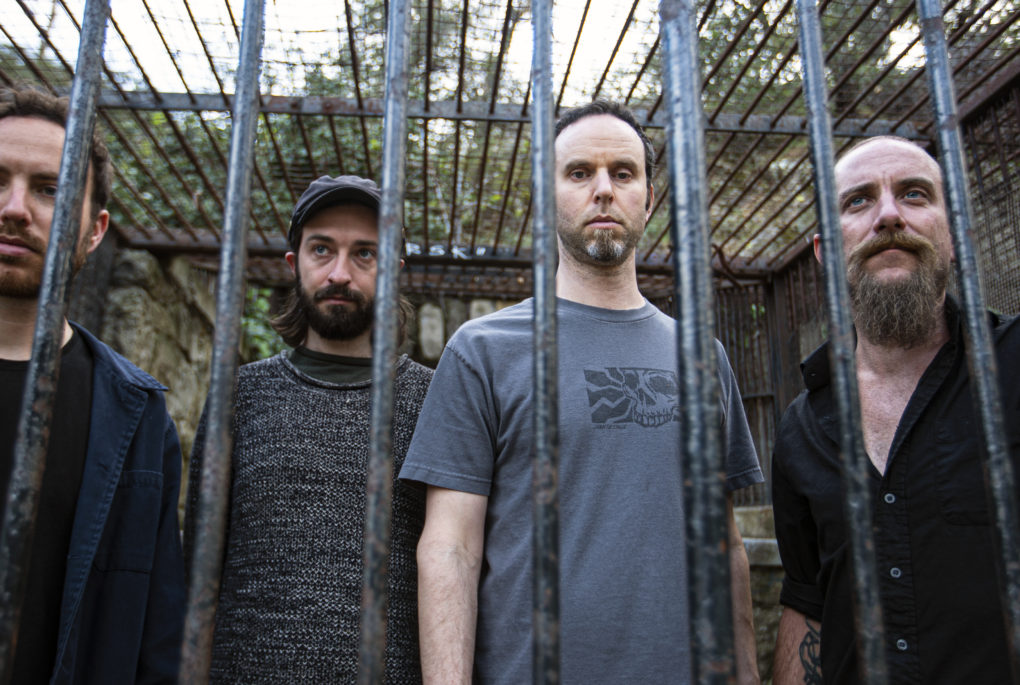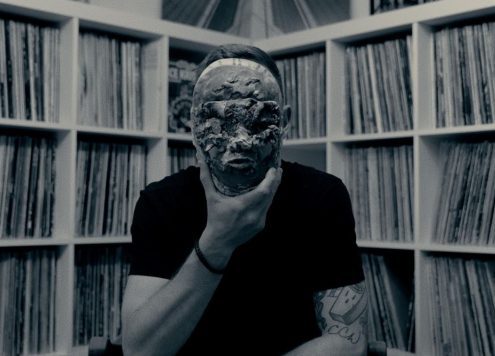Red Fiction founded in 2012 by Jason Schimmel in Los Angeles, California and has two prior releases under the Atomic Ape moniker: a full length album, Swarm, and 7” vinyl, Rampage, were both released in 2014 on Web of Mimicry. Jason Schimmel, who plays guitar, keyboard and bouzouki in Red Fiction is also a current member of Secret Chiefs 3, a band founded by Trey Spruance (Mr. Bungle, Faith No More), is a founding member of the defunct band, Estradasphere, and has performed concerts throughout the world with John Zorn’s Masada project.
Not to be overlooked, Red Fiction is also made up of Ryan Parrish (tenor and baritone saxophone), Max Whipple (bass), and Shawn Baltazor (drums) and has toured with Mike Watt, Behold the Arctopus, INUS, Neil Hamburger, Fartbarf, Duk, Burning Ghosts, Qui, Corima, and Major Entertainer.
Red Fiction’s latest, Visions of the Void, was composed, recorded and produced by Schimmel at The Bunker LA in Los Angeles and was mixed by Justin Phelps (Mr. Bungle, Dead Kennedys, The Mars Volta, Poison Idea, Amanda Palmer, Cake) and Schimmel at Hyde Street Studios in San Francisco. This album will be available on John Zorn’s label, Tzadik Records, November 13, 2020, and can be ordered here.
With a pedigree as pristine as Schimmel’s, Ghettoblaster was fortunate to catch up with him to discuss some of his favorite experimental compositions, pieces that shaped and informed his considerable and cutting-edge output still today:
Goblin, “Blind Concert”
1970s Italian progressive rock band, Goblin has always had a special place in my heart. This track is taken from their seminal score for Dario Argento’s film Suspiria released in 1977. This recording encapsulates everything that is great and unique about old school Italian horror film music. Funky drum and bass grooves, airy atonal atmospheric textures, wild spastic percussion, seemingly random analog synth noise, odd instrument panning and of course a phenomenal analog sound. What is there no to love?
Naked City, “Metal Tov”
My absolute favorite band from John Zorn’s massive catalog of music, this one comes from their fourth studio album, Radio, released in 1993. This band was extremely influential in my early days of discovering experimental music and in finding my true calling as a composer and musician. This one spoke to me right out the gates for its use of the very uncommon time signature of 15/16. This was also one of my first introductions to the technique known as “through-composed,” where no section of the composition is repeated. By using this approach Zorn creates an illusion of a familiar melodic and rhythmic structure but upon closer examination, one finds that things are subtly changing the entire time. The melody is another intriguing element of the composition because it is simultaneously both haunting and consonant. It’s so hard to put your finger on why this composition works so well…I guess it’s just the magical alchemy of John Zorn.
White Noise, “Firebird”
In 1969, the debut album, The Electric Storm, by electronic music group White Noise was released. “Firebird” is a song from the album that is filled with so many whacky sounds from out of this world that I have seriously never heard anything quite like it. What makes this avant pop masterpiece so astounding to listen to, is its wide use of one of the earliest modular synthesizers, the EMS Synthi VCS3. The song has so many “ear candy” moments that it’s literally impossible to keep track. Psychedelic do-wop vocals, harpsichord, contrabass, and theremin are all processed through highly advanced tape manipulations. But let’s not forget the mesmerizing lead vocal performance, sophisticated chord progression, and obscure poetic lyrics.
Mr. Bungle, “Ma Meeshka Mow Skwoz”
One of the most important and influential bands to me in my formative years. This one comes from their experimental art rock masterpiece, Disco Volante, released in 1995. The writing on this track was a real eye opener for me both as a composer and producer. You can really hear how every sound was so meticulously recorded that it conveyed a total stylistic authenticity to the listener. This track leans heavily on the mysterious sounds of the theater organ, an instrument widely used in horror films from the 1950s-’60s. Acting as the backbone to the track, the theater organ is woven together with cartoon like melodies, jarring sound fx and a jazz rhythm section. One of the real highlights here is the incredible range of Mike Patton’s vocal performance; from the abrasive screams, to angelic falsetto lines, to the virtuosic angular melodies, it is truly a remarkable thing to experience.
Amon Duul II, “Kanaan”
1960s-’70s German psychedelic rock and krautrock pioneers Amon Duul II have paved the way for a lot of my favorite bands from that era. This song came from their debut album, Phallus Dei, which was originally released in 1969. What I really love about this song is its tribal repetitive nature which really puts the listener under a sort of meditative spell. The sonics of this albums recording are so beautifully expansive and psychedelic sounding. Their use of unique instruments in a rock band setting like; chant vocals, vibraphone, raunchy fuzz electric guitars, Turkish drums, organs and abstract percussion make for a very awe inspiring listening experience.
Ennio Morricone, “La Lucertola” (theme from A Lizard In A Woman’s Skin)
This is the main theme from A Lizard In A Woman’s Skin film score released in 1971. There are so many remarkable aspects to note regarding Morricone’s approach to film composition and orchestration. One thing that has always struck a chord with me is the attention to detail, which is so apparent in the techniques utilized in the actual recording process. You can really hear that Morricone took the time to add subtle things like delay and echo effects and abstract noise from analog synthesizers to give the track a multi-dimensional, almost ambient sonic imprint. But the driving force behind the genius of this composition is the hauntingly beautiful female vocal melody which carries the listener through a series of unexpected harmonies and sonorities. There is no question why this composition leaves you in a state of wonder and euphoria.
Frank Zappa, “Echidna’s Arf (Of You)”
This song is found on the Roxy & Elsewhere album released in 1974 and is a testament to the true genius that was Frank Zappa. The first thing that struck me about this song was that it was so ridiculously tight that it seemed impossible to be a live recording. This massive 15-piece band consisted of two drummers, percussionist, full horn section, multiple keyboardists, guitarists, and vocalists. This song features a lot of the elements that have made me a huge fan of Zappa’s music; extremely intricate melodies and rhythms, blistering synth leads, super tight horn arrangements, and off the wall guitar acrobatics. To top it all off, it has the signature Zappa sense of humor that is present in most of his musical output throughout his career.
Fred Frith, “Hands of the Juggler”
This composition is taken from Frith’s second solo album, Gravity, released in 1980. It draws upon a wide variety of influences but the one that stands out to me is the heavy emphasis on Middle Eastern folk dance music. What I love about this piece is its truly elusive rhythmic structure and its unpredictable melodic writing. It twists and turns in directions that are both surprising and exhilarating. The exotic instrumentation of the track includes; violin, clarinet, mandolin, electric guitar, accordion, percussion, bass, and drums. I have listened to this track hundreds of times and still hear new things on every single listen.
King Crimson, “Larks’ Tongues In Aspic (Part II)”
Another one of my favorite bands from the 1970s prog rock movement. This cut comes from their fifth studio album, Larks’ Tongues in Aspic, released in 1973. The thing about this track is it really broke some new ground in terms of instrumentation for the time period. By augmenting the normal drum kit with objects like; sheet metal, toys, and baking trays it really enhanced and emphasized the brute impact of the rhythms. This novel approach to the drumming melded perfectly with the dark atonal structure of the guitar riffs. Another striking moment is the completely unhinged violin solo, which I had never heard in the context of a rock song. This heavily processed and distorted solo really gives this monumental composition an extremely hard edge.
Jerry Goldsmith, “The Demise of Mrs. Baylock”
This composition is from The Omen film score released in 1975. This is one of the first film score pieces that really spoke to me in terms of writing, orchestration and production. This cue has such a dark level of imagination; from the evil aggressive string writing, to the choir screaming and whispering satanic lyrics in Latin, to the piercing percussive stabs, 20th century extended techniques, and atonal woodwind and brass motifs. This composition takes you on a musical journey that is unlike anything you have ever heard.
Website | Instagram | Facebook and ATOMIC APE Website











Social Media